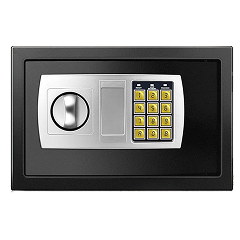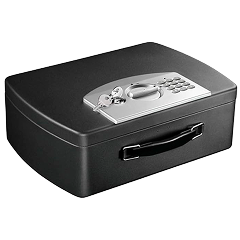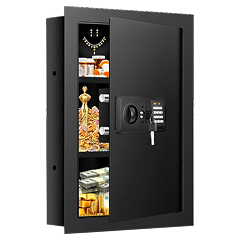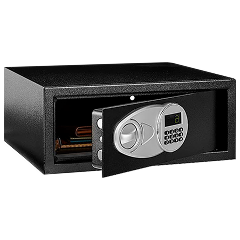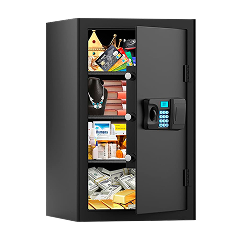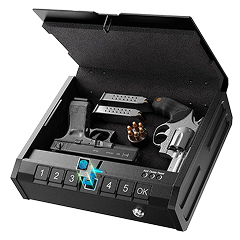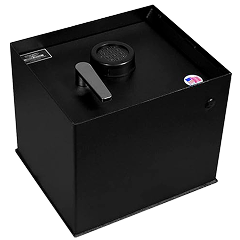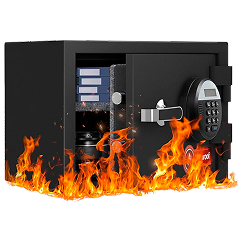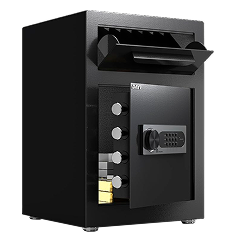Depository safes solve a specific problem that regular home safes can’t handle well: secure cash storage with one-way deposits. Unlike my 80-pound combination safe or portable fire safe, depository models feature a slot or chute that lets you drop money inside without opening the main compartment.
This design protects your cash from both theft and the temptation to “borrow” from your own stash. Businesses use them for daily receipts, but they’re also practical for homeowners who prefer cash transactions or need secure storage for side income.
I’ve researched depository safes extensively after realizing the limitations of my current setup. My portable keyed safe works fine for documents, but it’s not ideal for regular cash deposits. The combination safe is more secure due to its weight, but accessing it frequently becomes annoying.
This guide covers the technical specifications and features that matter most when choosing a depository safe, from lock mechanisms to capacity planning. You’ll get practical insights based on my engineering background and real-world experience with different safe types, plus research into what makes depository models worth the investment over standard home safes.
Burglary Ratings Explained
Some manufacturers slap vague security claims on their products, but burglary ratings give you actual, tested standards. From my engineering perspective, I appreciate that these ratings involve real break-in attempts using common tools, not just marketing fluff.
The testing simulates everything from prying and drilling to cutting attacks, which gives you a realistic picture of what a thief would face. My current safes don’t have official ratings, which is something I’d change if I bought them again.
When you pay more for a higher rating, you get beefier steel construction, tougher lock hardware, and stronger anchor points. You’re paying for time – specifically, how long it takes a determined burglar to break in. For depository safes handling regular cash deposits, this time buffer can mean the difference between losing your money and scaring off an intruder.
Common Burglary Rating Levels:
- No Rating – Basic security, minimal break-in resistance
- RSC (Residential Security Container) – Entry-level protection against hand tools
- B-Rate – Improved steel thickness and tool resistance
- C-Rate – Professional-grade construction with drill protection
- TL-15 – High-security rating, resists tools for 15 minutes
- TL-30 – Maximum protection, withstands 30-minute tool attacks
Dual Key vs. Combination Locks
After using both styles for a few years, I’ve learned that keys versus combinations really boils down to speed versus security. My portable keyed safe gets me into documents fast when I need them, but I constantly worry about losing that key or having someone swipe it during a break-in.
The combination safe weighs enough that nobody’s walking off with it, and there’s no physical key to lose or duplicate, but spinning that dial would get old fast if you’re making regular deposits.
Here’s how the two main lock types stack up for depository safes:
Bolt and Door Considerations
The number and placement of locking bolts make a huge difference in pry resistance, something I learned after examining my own safes closely. My combination safe has three bolts that engage when locked, while my smaller keyed safe has just one.
During my research, I’ve seen depository safes with anywhere from two to eight bolts, and the positioning matters as much as the count. Bolts that extend into all four sides of the door frame create much better protection against crowbar attacks than those that only secure the hinge side.
Door construction separates cheap safes from serious security. Thick steel doors with reinforced edges resist both cutting and prying attempts. From what I’ve observed in showrooms and online specs, quality depository safes use doors that are at least as thick as the body walls, often thicker. The door gap should be minimal when closed – large gaps give thieves something to grab onto with prying tools.
Pay attention to how the door mounts to the frame and hinges. Internal hinges prevent someone from simply removing the hinge pins, while external hinges should have non-removable pins or secondary locking mechanisms. The best depository safes I’ve researched feature doors that sit flush with the frame when closed, creating a seamless barrier that’s much harder to attack than doors with obvious weak points around the edges.
Anchoring and Placement Options
Your installation options depend heavily on the safe’s weight and your security needs, though I’ll admit my experience here comes from research rather than hands-on installation work.
Floor Mounting Considerations
Most depository safes over 200 pounds benefit from floor anchoring, even though the weight alone deters casual theft. From what I’ve learned, concrete gives you the best foundation for expansion bolts or chemical anchors, but wooden floors get tricky since you need to hit the floor joists or add reinforcement plates underneath.
You want mounting holes that come pre-drilled from the factory rather than having someone drill them on-site, which can compromise the safe’s strength. Most installers I’ve talked to suggest at least four anchor points for smaller safes, bumping up to six or eight bolts for larger units.
Business Installation Options
Businesses often go with under-counter or through-wall setups to hide the safe while keeping it accessible for staff. Under-counter installations make the safe disappear completely but require custom cabinetry and proper ventilation considerations.
Through-the-wall installations put the deposit slot on one side and the main door on the secure side, which I’ve seen work well for retail environments where customers need deposit access but staff retrieval happens in a back room.
Portability vs. Security Trade-offs
Lightweight depository safes under 100 pounds offer flexibility but sacrifice security without proper anchoring. My portable keyed safe taught me that anything you can carry, a thief can carry too.
However, some situations call for portability. For example, temporary cash collection at events or rental properties where a permanent installation isn’t feasible. The key is matching the safe’s security features to its installation method rather than assuming weight alone provides adequate protection.
Capacity Planning
Getting the size right from the start saves you from needing to upgrade later, which I learned the hard way with my current setup. My small safes work fine for occasional document storage, but they’d be useless for regular cash deposits from a side business or rental income.
Think beyond just bills when calculating space. You might need room for coin rolls, deposit bags, or important documents alongside your cash. I’ve found that most people underestimate their storage needs by at least 30%, especially if their cash flow grows over time.
How you organize deposits and who needs access will determine whether you want single or multiple compartments. One big compartment gives you maximum flexibility and costs less upfront, but everything gets mixed together unless you use separate containers inside. Multiple compartments let you separate different income streams or give different people access to specific sections without opening the entire safe.
From what I’ve researched, the multiple-compartment models usually sacrifice some total volume for the added organization, so you’re trading space for convenience.
Depository Chute Features
The deposit mechanism itself varies between manufacturers and directly impacts both security and usability in daily operation.
Hopper vs. Slot Designs
Hopper-style deposits use a larger opening with a hinged door that drops cash into an internal collection area, while slot designs force deposits through a narrow opening into anti-fish baffles. I’ve seen both types in person, and hoppers handle bulk deposits better – think multiple bills or envelopes at once.
Slot designs offer better security since the narrow opening makes it nearly impossible to reach inside and fish out deposits, but they can jam more easily with folded bills or thick envelopes. Those baffles in slot designs work like a maze. Once your money goes in, there’s no fishing it back out with wire or tools.
Tamper Detection and Access Control
Lots of depository safes come with tamper indicators that show if someone’s been messing with the deposit chute or trying to break in. You’ll see everything from basic seals that break if disturbed to fancy electronic sensors that log every access attempt.
Some models let you lock down the deposit function completely, which comes in handy when the safe is full or you’re doing maintenance. I’ve read about business applications where managers can disable deposits during shift changes or when preparing for cash pickups.
Integration with Business Systems
The fancy depository safes can hook up to point-of-sale systems, cash registers, or teller counters for smooth cash handling. The deposit chute might connect directly to a cash drawer or include electronic counting features that track deposit amounts.
While this level of integration goes beyond most home applications, it shows how seriously manufacturers take the operational side of cash handling. Even basic models should have smooth deposit action and clear visual confirmation that your money made it inside the safe compartment.
Upgrading from a Regular Safe
My current setup taught me exactly why basic home safes fall short for regular cash storage. The portable fire safe works fine for important documents I rarely access, but opening it multiple times per week for deposits would get annoying fast.
My combination safe offers better security thanks to its weight, but the lack of a deposit slot means I would be tempted to leave it unlocked between uses, defeating the whole purpose.
Basic safes don’t have anti-fishing features to stop someone from reaching inside to grab deposits, and most lack the interior layouts designed specifically for cash organization.
Jumping from a basic home safe to a quality depository safe costs serious money, but the security and convenience improvements pay off if you handle cash regularly. You’re paying for specialized engineering like deposit chutes, anti-theft baffles, and higher burglary ratings that most home safes skip.
The decision comes down to whether you need the depository function enough to justify spending $800-$2,000 instead of $200-$500 for a basic safe.
What Features to Prioritize When Upgrading
- Deposit chute with anti-fish baffles – Prevents retrieval of deposited cash
- Higher burglary rating – At least RSC, preferably B-Rate or better
- Multiple locking bolts – Four or more bolts distributed around the door
- Thicker steel construction – 10-gauge body walls minimum
- Proper capacity planning – At least 50% more space than you think you need
- Quality lock mechanism – Electronic with backup key beats basic combination
- Floor mounting capability – Pre-drilled anchor points for permanent installation
Key Maintenance and Management Tips
When you’re storing cash, key control becomes way more important, especially if other people need access to your depository safe.
- Write down every key you make – After losing my fire safe key for three weeks and freaking out about locksmith costs, I learned this lesson the hard way.
- Store backup keys somewhere else – Don’t keep spare keys anywhere near your main safe.
- Replace locks when employees quit – Staff turnover creates security holes that most homeowners never think about.
- Don’t make more keys than you need – Every extra key is another chance for theft or loss.
- Go electronic for business use – You can change codes instantly when people leave, unlike physical keys that require lock changes.
- Make safe access part of your security system – Your safe key should fit into your bigger picture for home or business security.
How to Choose the Right Depository Safe for You
Start by honestly assessing your cash volume and deposit frequency, then size up by at least 30% to avoid outgrowing the safe too quickly. Pick your burglary rating based on actual security needs.
Homeowners with occasional cash deposits can get by with RSC-rated safes, while businesses handling daily receipts need B-Rate or better. Lock choice depends on who’s using it: keys work great for single users, while electronic locks make more sense when multiple people need access or you want to change codes regularly.
Spend your money on features that actually matter instead of trying to get every bell and whistle. A quality deposit chute with anti-fish baffles, proper steel thickness, and multiple locking bolts will serve you better than a cheaper safe loaded with unnecessary electronics. After dealing with undersized safes for years, I’ve learned that buying the right safe once beats upgrading later when your needs outgrow your gear.


